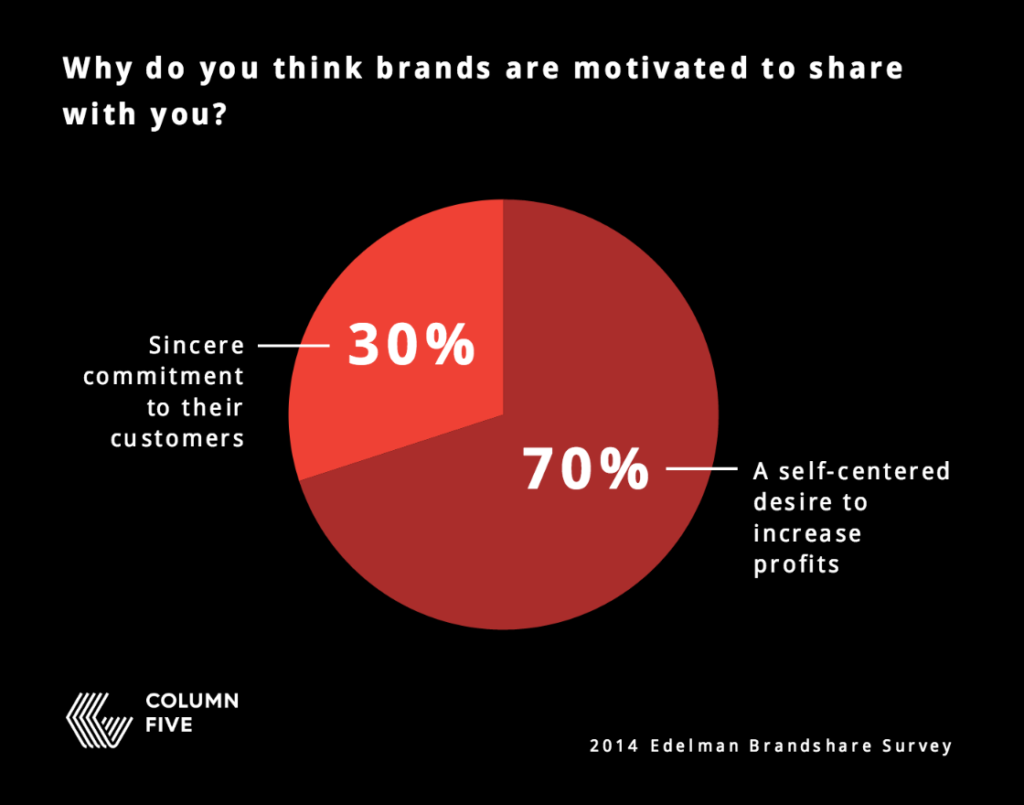June 13, 2017
WHY THE WORLD NEEDS DATA-BASED STORIES MORE THAN EVER
This article originally appeared on Column Five.
There has never been a more confusing, more incendiary time in the media than this moment. Fake news, pundits, think pieces, op eds, blogs, Twitter feeds, and a trillion other platforms are disseminating information, yet opinion is reigning supreme over facts. Many of us have become disillusioned, retreating to our corners and shaking our heads. We are in the middle of a credibility crisis, and that’s why data-based stories are needed more than ever—especially for marketers.
Many groups, particularly millennials, are suspicious of brands’ intentions. The 2014 Edelman Brandshare survey found that 70% of consumers think brands only share information with them to increase profits.

So how can brands fight this sentiment? How can they break through that barrier of skepticism to deliver credible and valuable information? Data can help.
WHY WE NEED DATA-BASED STORIES
Too much marketing is one-sided. It serves the brand, not the audience. The whole reason we create content is to communicate and cultivate genuine relationships with people. But to foster true connection, that stuff we put out needs to be relevant, interesting, and worthwhile. Above all, it needs to be credible.
When it comes to the relationship between a brand and audience, credibility is everything. It’s not enough to have a great product or a solid service offering. People want to trust the people behind these products and services.
Readers are looking to you to guide them to the right decisions about your product or service. They want to know that you have their back and best interest at heart. They want to know you’re genuinely invested in helping them. They want and need to trust you.
Data-based stories are uniquely positioned to help you foster that trust. A strong data set reveals truths in cold, hard numbers. Dig into data and you uncover stories in the form of trends, correlations, outliers, and more. These stories may provide a big-picture view or hone in on a specific subject, but the insights extracted have very real-world consequences. Data storytelling can influence your audience’s behavior, expand their knowledge, and shift perspective in powerful ways.
By crafting a strong narrative anchored by solid data, you are creating content of substance. Whether a simple infographic or a large interactive, data-based storytelling gives you something to hang your hat on.
THE ELEMENTS OF TRUST
Again, in the current climate, where feelings and facts are blurred beyond recognition, data is a port in the storm.
Data provides evidence: If you can show your audience the data, not just “tell” them what you think, they will be far more likely to listen to you. When you are trying to deliver a certain message or takeaway, a story backed up by concrete evidence is much easier to trust.
Data storytelling provides transparency: The very act of transparency—showing them the data, especially if it’s internal—also demonstrates that you are vulnerable and willing to let them into your world. This is a great gesture of mutual trust.
DATA-BASED STORIES AND YOUR ORGANIZATION
Beyond the benefit to your audience, data storytelling also cultivates trust within your own organization.
It builds your credibility: You have a larger audience than you realize. Beyond customers or fans, you have colleagues, competitors, potential employees, industry contacts, and many more paying attention to the content you create. The more you demonstrate your interest and expertise, the more it will help your reputation in larger spheres.
It builds confidence: The better you can extract and communicate insights, the better you can make decisions. This builds confidence throughout your organization—confidence that your decisions and actions are informed by real-world data, which is important for your bottom line and company morale. Data provides an anchor for your team to gather around, so there are fewer arguments based on feelings or ego and more constructive discussions centered around data.
HOW TO DIVE INTO DATA STORIES
Telling great data stories just takes a little practice. If you don’t know where to start or you need a little refresher, here are a few things that might help.
- Look at these 9 sources to find great data for your next piece of content.
- Learn how to craft an effective narrative.
- Design your data according to best practices.
Source: Visual News

0 Comments
Leave A Comment